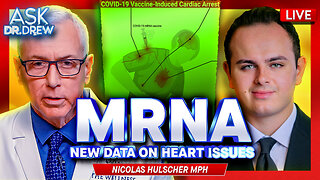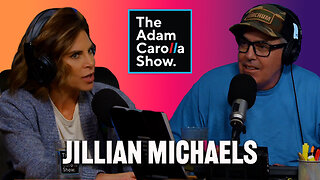Premium Only Content

Osteochondrosis and Headaches, their symptoms and how to treat them naturally
Osteochondrosis of the Neck (cervical spine)
In the neck area there are a lot of vessels and nerves that feed and innervate the tissues of the neck, skulls and faces. One of the largest arteries - the vertebral artery passes precisely in the holes of the vertebrae. Therefore, changes in them lead to disruption of the normal course. arteries, which will manifest itself as persistent headaches and increased fatigue.
The cervical vertebrae fit more closely together. Therefore, for any, even minor pathological changes in the spine or increased stress on it disrupts the normal functioning of the entire department. Often a herniated disc of the vertebra appears, that is, its mixing inward, towards the vertebral channel where the brain is located. This is manifested by a disorder of the sensitivity of the skin and muscles not only the neck and face, but also the arms and legs. Weakening of motor activity muscles, with weakness or even complete inability to move. In this case, there may be a feeling of itching or "passing of an electric current" along the arms and legs when bending the neck - this helps to make a diagnosis. These disorders arise suddenly, which distinguishes them from tumors of the spine and spinal cord.
Other symptoms of cervical osteochondrosis may be a feeling of numbness or swelling in the tongue, impaired movement, pain in the collarbone, weakness and decreased muscle tone in the neck and shoulders. Headaches and neck pain may worsen with movements in the neck, or, conversely, with its prolonged monotonous position (in front of TV screen, after a long sleep, especially on a thick and high pillow).
Another common symptom is pulling or pressing pain in the left side. chest and in the left hand.
Complications of cervical osteochondrosis can be arthrosis of the shoulder, elbow or clavicular joints, with impaired mobility in them and pain when moving the arm and shoulder.
With a decrease in the height of the intervertebral disc, a decrease in the elasticity of the fibrous rings in different segments of the cervical spine.
One of the signs of cervical osteochondrosis may be constant tinnitus. Such noise is especially tiring and even annoying in conditions of isolation from external noise. Sleep is disturbed, general nervousness increases, a person begins to hear worse. To
get rid of the noise, you need to treat osteochondrosis. If the treatment of the underlying disease is effectively, the noise will stop over time. Treatment of osteochondrosis of the cervical spine consists of medical and physiotherapy measures. Medical treatment is mandatory, since the blood supply to the brain suffers.
Also have a positive effect products based on chondroitin sulfate. Apply acupuncture and manual therapy according to indications. Also appointed physiotherapy procedures (paraffin, ozokerite, electrophoresis etc.) and therapeutic gymnastics courses. Physical activity and body position should help, limit the time of working on the computer, change the pillow to a lower and softer one, and the mattress to a harder one. Massage courses are very effective, and not only the cervical spine, but also the back surface of the body and hands, since the cervical osteochondrosis is often combined with chest disease. In the treatment of folk remedies, warming procedures, infusions and herbs tea.
Prevention and treatment of cervical osteochondrosis include feasible physical activity. Medical gymnastics must be carried out, otherwise it is constantly spasmodic neck muscles will cause irreversible changes in the spine. Prevention of cervical osteochondrosis is the correct posture (straight back and neck), comfortable working place where you do not need to constantly bend your back and neck.
The cure of cervical osteochondrosis is difficult, as all others parts of the spine, however, you can achieve persistent improvement, the absence of exacerbations diseases. To strengthen the muscles that hold the intervertebral discs, you need to do special physical exercises.
Tension headaches
They are also called "tension pains". They are the most common. At least once in 8 out of 10 people Felt headaches. Tension headaches also occur in children, usually with excessive exertion in school and after school. Most often, these pains occur at the end of a long day of work, especially if a person for a long time is in the same uncomfortable position. Doctors believe that the reason theirs is associated with muscle tension. The muscles of the head and neck are in constant tension, so the blood flow in them is disturbed. Nutrients are supplied to the muscles less and less, and the products exchange worse. As a result, irritation occurs nerve cells and pain occurs. The pain tightens the head like a "helmet" and more in the evening.
By the way, researchers attribute to the reasons for such a prevalence of headaches tension pain is that behind them is masked by stress or depression. With a headache the symptoms of stress and depression seem to be hiding, and the person only knows that he is tired and his head hurts.
Another reason that an ordinary person cannot even think of is medications. Drinking more than 45 grams of aspirin or its equivalents per month may cause tension headaches.
Tension headaches can be episodic or chronic. Chronic make up (fortunately) only 3%. There are clear diagnostic criteria for tension headache that developed by the International Headache Association:
- the duration of a headache episode should be at least 30 minutes. When
episodic pain can last from 30 minutes to 7 days. With chronic
possible daily, almost never-ending headaches;
- the nature of the headache is squeezing, constricting;
- the head hurts entirely, that is, from both sides. However, one side may hurt.
stronger;
- the headache is not aggravated by the usual daily physical activity,
however, it clearly interferes with living and working;
- when the headache intensifies, other symptoms may appear, such as abdomen pain, decreased appetite, nausea, tingling sensations in the heart, irritability,
poor tolerance to daylight or sounds. But this is individual and does not occur
often.
Episodic headaches include tension headaches, in which the number of days from
headache does not exceed 15 per month or 180 days per year. For chronic - exceeds
15 days a month or 180 days a year.
How to distinguish this particular headache from others? She has certain signs:
- concomitant muscle tension in the neck-collar zone,
- massage or warming the neck and head brings relief,
- the headache begins without warning signs,
- headache often occurs against a background of stress,
- she rarely wakes up at night (only 10% of people can wake up at night from
tension headaches),
- headaches begin mainly in adulthood (only about 10
% of people say that they had a headache in childhood),
- the severity of the headache changes frequently throughout the day,
- headaches can get worse early in the morning and in the evening. Sometimes severity
maximum between four and eight in the morning, as well as between four and eight
in the evening.
If it is the tension headache that has begun, then it is better to lie down, relax, give
rest for tired muscles. You don't have to watch TV or sit at the computer, this is
will only increase the negative impact of an uncomfortable posture.
After all, the muscles of the back and neck will be tense. But a walk in the fresh air will help. If you don't want to go for a walk or there is no opportunity, then you should at least ventilate room. Sometimes self-massage of the head and kneading of the neck-collar zone helps. It does not help everyone, here you have to look at the result. Some are helped by tea made from lavender or chamomile leaves and flowers. Also mint tea helps. After tea it would be nice to sleep. You can also make a cold compress with essential with mint or lavender oils: drip 2-3 drops into a bowl of cold water, moisten a small towel, wring out and put on the forehead. Respiratory gymnastics or aromatherapy helps a lot. Can be done at home 5-10 minutes hot foot or hand bath. Or put a hot squeezed towel on your forehead, massage neck and shoulders, drink green tea (but no chocolate and sweets).
If you are constantly working at the computer, you need to arrange every 45 minutes 5-10 minute breaks. It is important not just to take your eyes off the monitor, but to walk on warm up in the room: this will improve the blood flow in the stiff muscles. Self-massage of the head helps well: it relieves muscle tension - the cause unpleasant sensations. You can carry out the the headache massage brush. At the same time, blood circulation increases, and the muscles relax, restore normal blood circulation. If such pain appears several times a week, then something needs to be done: physical exercises, massage, changing the working position. Otherwise, the consequences will be even worse and even more painful.
It is necessary to establish a routine of work and rest, food, do not forget about physical activity, because most often the head hurts so in someone who all day sits at the workplace. Other natural methods include relaxation therapy, massage, manual therapy, acupuncture, physiotherapy, water procedures. Physical education is useful for such people: swimming, cycling, hiking, jogging, stretching.
Thanks for watching this video to the end. Today we discussed What is Osteochondrosis and Headaches, about their symptoms and how to avoid their occurrence and how to heal them naturally. I hope it will help you. Subscribe to my channel and will see you again.
-
 1:11:24
1:11:24
Dr. Drew
5 hours agoNEW: Cardiac Arrest In Healthy Young People After mRNA w/ Nicolas Hulscher – Ask Dr. Drew
38.5K21 -
 4:24:53
4:24:53
Right Side Broadcasting Network
9 hours agoLIVE REPLAY: President Trump and UK Prime Minister Starmer Meet and Hold a Press Conference 2/27/25
134K46 -
 2:12:33
2:12:33
Adam Carolla
2 days agoKamala Harris vs. Trump Wildfire Response + Jillian Michaels on Motherhood/Ayahuasca & Sperm Donors!
35.8K12 -
 4:18:28
4:18:28
Barry Cunningham
8 hours agoTRUMP DAILY BRIEFING: PRESIDENT TRUMP AND UK PRIME MINISTER STARMER HOLD PRESS CONFERENCE!
55.8K11 -
 1:44:47
1:44:47
The Quartering
5 hours agoEpstein Files RELEASED Today, Gene Hackman Mystery & Trump Vs Woke Reporters!
85.9K34 -
 1:19:38
1:19:38
Ben Shapiro
5 hours agoEp. 2147 - HUGE: The Washington Post SURRENDERS…To Reality!
97.9K20 -
 1:01:36
1:01:36
Russell Brand
18 hours agoThe Battle for Power: Trump’s Plan, Elon’s Purge & the DEI Illusion – SF545
198K76 -
 1:58:33
1:58:33
The Charlie Kirk Show
5 hours agoAmerica's Spiritual Revival + Runaway Judges + Vivek For Ohio | Habba, Waggoner, Vivek | 2.27.2025
143K23 -
 58:33
58:33
The Dan Bongino Show
8 hours agoAmerica's A-Team Hits The Ground Running (Ep. 2432) - 02/27/2025
902K1.4K -
 1:19:38
1:19:38
The Rubin Report
7 hours agoCNN Host Brutally Mocked for Trying to Profit Off of What He Called a ‘Conspiracy’
103K72